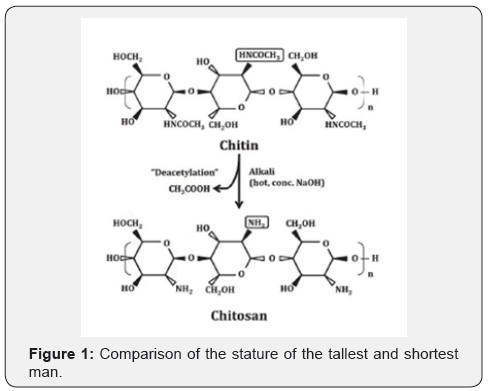Chitosan Fiber in Textile Engineering: Advanced Dressing from a Natural Source - Juniper Publishers
Journal of Fashion Technology- Juniper publishers
Abstract
Chitosan is a naturally-occurring starch (polymer) derived from the shells of crustaceans. Chitosan consists of primarily of 2-amino-2-deoxy-D-glucopyranose unit linked by β-(1-4) linkage, and small amount of N-acetyl-D-glucosamine residues. Chitosan has been found with important and wide properties in agriculture, antimicrobial field, cosmetics, food, medicine, and textile engineering. Many researches showed chitosan had antimicrobial activities on bacteria, postharvest pathogens, plant phytopathogenic fungi, yeast and virus. Here, the authors mentioned beneficial effects of chitosan-based materials in advanced wound dressings.
Keywords: Chitosan; Textile engineering; Wound dressing, Polysaccharide; Crustaceans; Diatoms sponges; Biomedical applications; Biodegradable biopolymer
Introduction
Chitin (β-(1-4)-poly-N-acetyl-D-glucosamine) is widely distributed in nature and is the second most abundant polysaccharide after cellulose. Chitin is often present in crustaceans, fungi, yeasts, diatoms sponges, corals, molluscs, and worms. As chitin is not readily dissolved in common solvents, it is often converted to its more deacetylated derivative, chitosan. Even though chitin and chitosan are known to have important functional activities and are used in food and biomedical applications [1]. Chitosan, derived from chitin, is composed of randomly distributed-(1-4)-linked D-glucosamine and N‐acetyl‐D‐glucosamine (Figure 1). It is usually obtained by treating the chitin shells of shrimp and other crustaceans with sodium hydroxide. Chitosan has received considerable attention as a functional, renewable, nontoxic, and biodegradable biopolymer for diverse applications, especially in pharmaceutics, food, and cosmetics. In the medical field, chitosan has been developed not only as artificial skin and a wound healing accelerator, but also as a new physiological material due to its antitumor, immunoenhancing, and antimicrobian properties [2]. Chitosan can be gained from chitin through alkaline hydrolysis of the N-acetyl groups. Chitosan degradation occurs by non-specific enzymes such as lysozymes, chitinases, cellulases or hemicellulases, proteases, lipases, β-1,3-1,4 glucanases as well as chitosanases.

Discussion
Chitosan-based materials: Advanced dressing from a natural source
Chitin, together with its derivatives, has been shown to be useful as a wound dressing material and chitosan-based materials are an essential candidate for tissue engineering [3]. Bleeding is the number one killer on the battle field and it is crucial that all military personnel know basic first aid to stop bleeding in a combat zone. It also has other proven properties that are beneficial throughout all stages of wound healing [4]. For example, accelerates healing [4] stimulates the immune response [5], has antimicrobial (bacteriostatic and fungistatic) [6], haemostatic [7], non-toxic to the wound bed and biocompatible and biodegradable properties [3] and are effective in managing exudate [8]. Due to the extensive history of chitosan use in emergency, military, and retail first-aid, use of the Chitosan bandage is one way to control serious arterial bleeding. The chitosan bandage IS NOT used for wounds with minimal to moderate bleeding and it is recommended to be used in conjunction with a tourniquet to control severe arterial bleeding [9]. Due to its absorbent properties, chitosan locks fluid within its core, reducing the lateral wicking action seen in other exudate management dressings. Chitosan also has an accelerating effect on wound healing [10] by activating immune cells through its cytokine production, giant cell migration, and stimulating type IV collagen synthesis [11]. The positive charge of chitosan fibers also enables them to halt bleeding by binding to negatively charged red blood cells, resulting in faster coagulation. By polymerizing with blood to form a net-like structure, the fibers further capture red blood cells leading to clotting. Also, some researches approved the positive charge of -NH2 groups of chitosan has main contribution to the antimicrobial activity. In fact, chitosan works by creating a positive charge, hence interacting with negatively charged molecules such as gram positive bacteria, blood cells, proteins and lipids [12]. Research showed that whole blood formed a coagulum rapidly upon exposure to chitosan the results of the blood coagulation time (BCT) showed that chitin and chitosan reduced BCT significantly in a dose-dependent manner, and they enhanced the release of the platelet derived growth factor-AB (PDGF-AB) and the transforming growth factor- β 1 (TGF- β 1) from the platelets, particularly with chitosan [13].
Conclusion
The use of chitosan-based materials in wound dressing has arisen as a research focus in the past two decades. Here, we introduce the roles of chitosan-based constituents as a natural biomaterial in treating one of the complications in human life.




Comments
Post a Comment